U.S. Army + U.S.A.F. Urgently Need More UAV Pilots
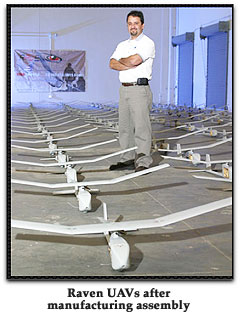 While the U.S. Air Force struggles to train 400 UAV operators a year, the U.S. Army is training 1,400, and is increasing that to 2,300 by next year.
While the U.S. Air Force struggles to train 400 UAV operators a year, the U.S. Army is training 1,400, and is increasing that to 2,300 by next year. Most of the army operators use the small (five pound)
Raven UAV, which provides platoons, companies, and vehicle convoys with aerial reconnaissance. Interestingly, UAV operators spend about 1,200 hours a year controlling UAVs in the air, versus 450 hours for army helicopter pilots and even less for air force pilots in the combat zone. Most army UAV operators are enlisted troops, while all USAF operators are officers. The Raven training lasts approximately 80 hours, but this tiny UAV was designed for ease of use. It takes about five times longer to train operators for larger UAVs such as the
Shadow and
Predator.
The U.S. Army also has over a hundred larger UAVs, most of them the 350 pound
RQ-7B Shadow 200s and 1,600 pound
MQ-5A Hunters.
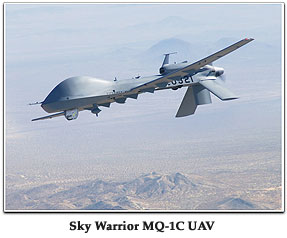
The U.S. Army has also started to receive the new 1.5 ton
Sky Warrior MQ-1C UAVs. The MQ-1Cs are slightly larger Predators, and are meant to replace the aging Shadows and Hunters. The big difference is that Sky Warrior can carry weapons (such as
Hellfire missiles.)
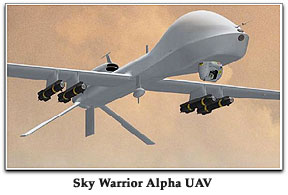
In addition, for the last two years, the U.S. Army has been using 20, one ton, Predator type UAVs (called
Sky Warrior Alpha) from the same firm that manufactures the Predator and Sky Warrior. "Alphas" were used in Iraq for counter-IED (roadside and suicide bombs) work. The Sky Warrior Alpha can carry 450 pounds of sensors and 300 pounds of weapons, and they have been used to fire Hellfire missiles. Sky Warrior Alpha is, officially, the
I-Gnat ER, which is based on a predecessor design of the Predator, the
Gnat-750, and an improved model, the
I-Gnat (which has been in use since 1989). The
I-Gnat ER/ Sky Warrior Alpha looks like a Predator, but isn't — in terms of design and capabilities, they are cousins.
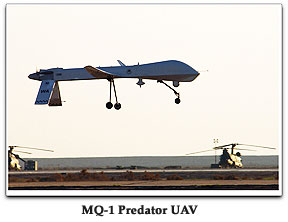
The
MQ-1C Sky Warrior weighs 1.5 tons, carries 300 pounds of internal sensors, and up to 500 pounds of external sensors or weapons. This UAV has an endurance of up to 36 hours and a top speed of 270 kilometers an hour. Sky Warrior has a wingspan of 56 feet and is 28 feet long. The Sky Warrior can land and take off automatically, and can carry four Hellfire missiles (compared to two on the Predator). The original MQ-1 Predator is a one ton aircraft that is 27 feet long with a wingspan of 49 feet. It has two hard points, which usually carry one (107 pound) Hellfire each. Each hard point can also carry a
Stinger air-to-air missile. Max speed of the Predator is 215 kilometers an hour, max cruising speed is 160 kilometers an hour. Max altitude is 25,000 feet. Typical sorties are 12-20 hours each. A Sky Warrior company has 115 troops, 12 Sky Warrior UAVs and five ground stations.
As its model number (
MQ-1C) indicates, Sky Warrior is a Predator (MQ-1) replacement. The U.S. Air Force plans to replace its MQ-1s with MQ-1Cs. Sky Warrior began mass production this year, and the U.S. Army (which paid for development) wants more than 500 of these craft, initially. So far, the attrition rate of Predators has been over five percent a year. Unless that can be brought down, few Predators will last more than a decade, and the MQ-1C will gradually replace it. Most of the losses are due to mechanical, electronic, software or operator failure. Never have so many UAVs been used so extensively, and intensively, in combat.
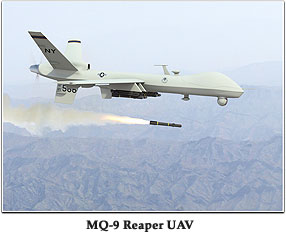
There is a third member of the Predator family, that is only used by the U.S.A.F. The
MQ-9 Reaper is a 4.7 ton, 36 foot long aircraft with a 66 foot wingspan that looks like the MQ-1. It has six hard points, and can carry 1,500 pounds of weapons. These include Hellfire missiles (up to eight), two Sidewinder or two
AMRAAM air-to-air missiles, two
Maverick missiles, or two 500 pound smart bombs (laser or GPS guided.) Max speed is 400 kilometers an hour, and max endurance is 15 hours. The Reaper is considered a combat aircraft, to replace
F-16s or
A-10s. (Content source:
Strategy Page).
Topical Tags :
Regional Tags :

